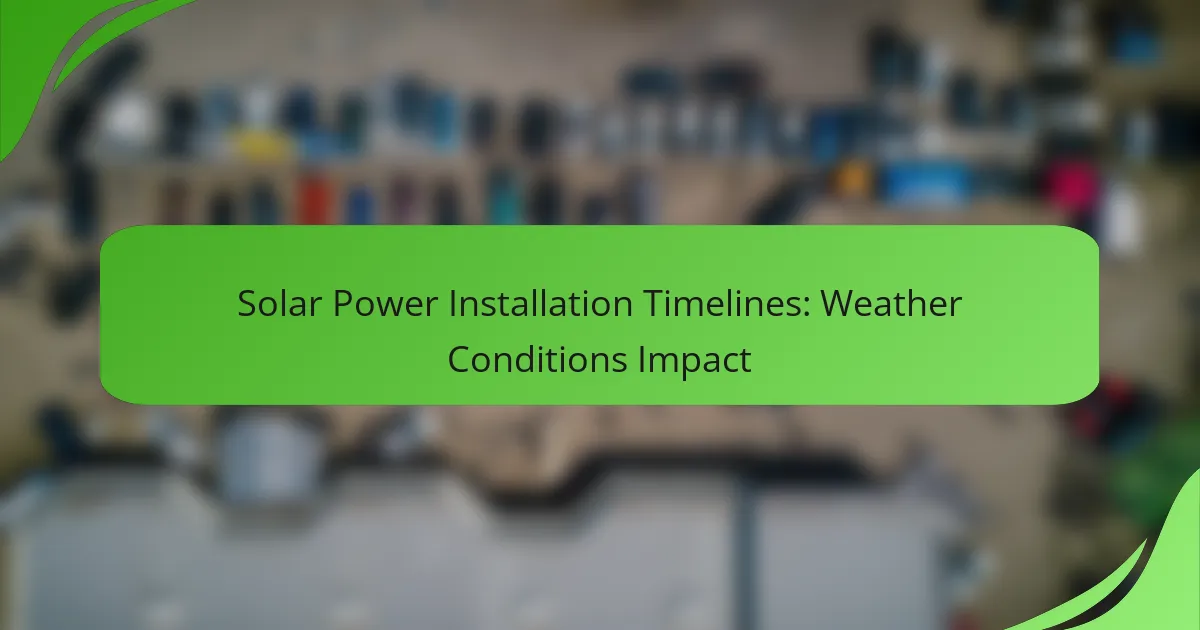Weather conditions play a crucial role in determining the timelines for solar power installations, as they can significantly affect scheduling and efficiency. Factors such as rain, temperature extremes, and wind can lead to delays, making it essential for project managers to understand these impacts to optimize planning and execution. In regions like California and Florida, specific seasons may offer more favorable conditions, further influencing the overall installation process.
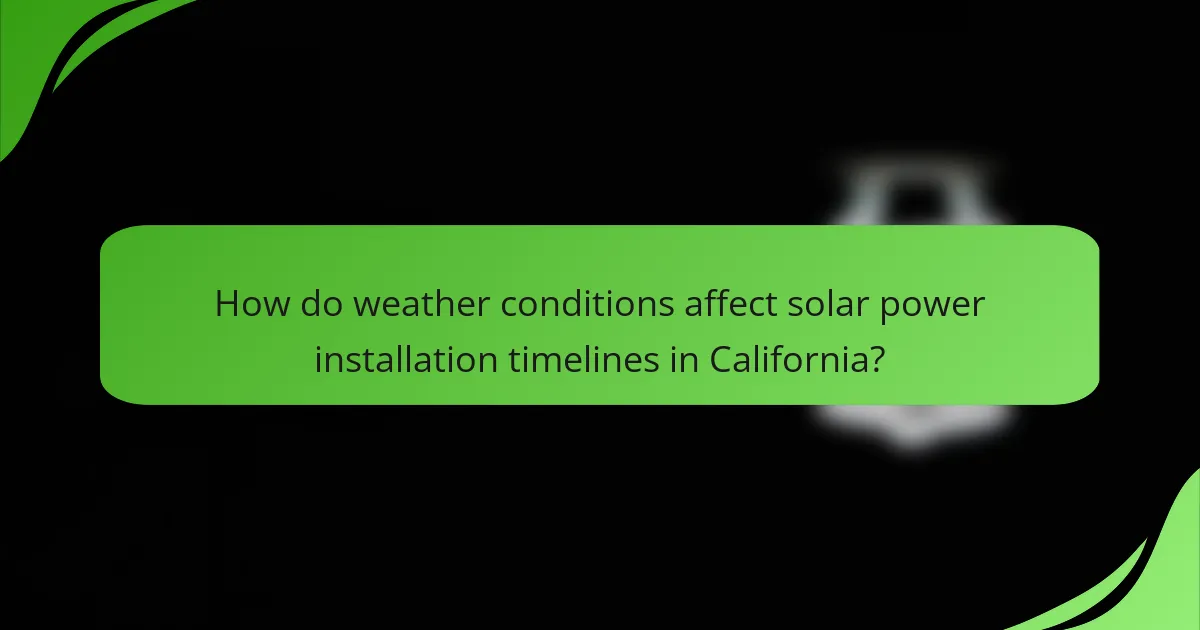
How do weather conditions affect solar power installation timelines in California?
Weather conditions significantly impact solar power installation timelines in California, affecting scheduling and efficiency. Factors such as rain, temperature, and wind can cause delays and influence the overall installation process.
Rain delays
Rain can lead to significant delays in solar power installations, particularly during the winter months when precipitation is more common in California. Wet conditions can make rooftops slippery and unsafe for workers, leading to postponements.
Additionally, rain can affect the curing time of adhesives and sealants used in the installation process. Installers often wait for dry conditions to ensure that all materials adhere properly, which can extend the project timeline.
Temperature impacts
Extreme temperatures can also influence solar power installation timelines. In California, high temperatures can pose risks for workers, leading to potential delays due to heat exhaustion or safety concerns. Installers may choose to work during cooler parts of the day to mitigate these risks.
Conversely, low temperatures can affect the performance of certain materials, such as batteries and solar panels. Installers may need to adjust their schedules to accommodate the best conditions for material performance, potentially lengthening the installation period.
Wind effects
Wind can pose challenges during solar power installations, particularly in coastal areas of California where gusts can be strong. High winds can make it unsafe to work on rooftops or to lift heavy equipment, leading to delays.
Installers often monitor wind conditions closely and may halt work if gusts exceed safe levels. This precaution can add time to the overall installation process, especially if windy conditions persist over several days.
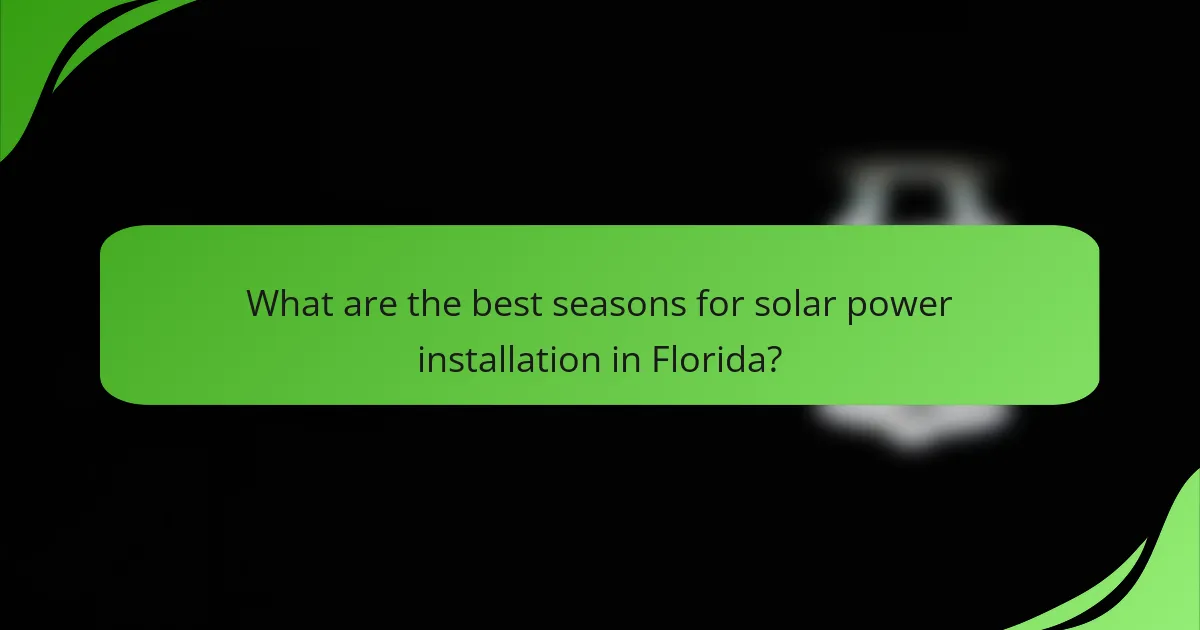
What are the best seasons for solar power installation in Florida?
The optimal seasons for solar power installation in Florida are typically the dry season, which runs from November to April. During this period, weather conditions are more favorable, leading to quicker installation times and better overall efficiency.
Dry season advantages
The dry season in Florida offers several advantages for solar power installation. With less rainfall and lower humidity, the risk of weather-related delays diminishes significantly. This allows contractors to work more efficiently, often completing installations in a shorter timeframe.
Additionally, clear skies during this season enhance the performance of solar panels post-installation. This means homeowners can start benefiting from energy savings sooner, maximizing their return on investment.
Humidity considerations
Humidity levels in Florida can be quite high during the summer months, which can complicate solar power installations. Excess moisture can lead to delays due to safety concerns and equipment handling issues. Contractors may need to schedule installations during cooler parts of the day to mitigate these effects.
Moreover, high humidity can impact the curing time of adhesives and sealants used in the installation process. It’s crucial to plan installations during the dry season to avoid these complications and ensure a smooth installation experience.
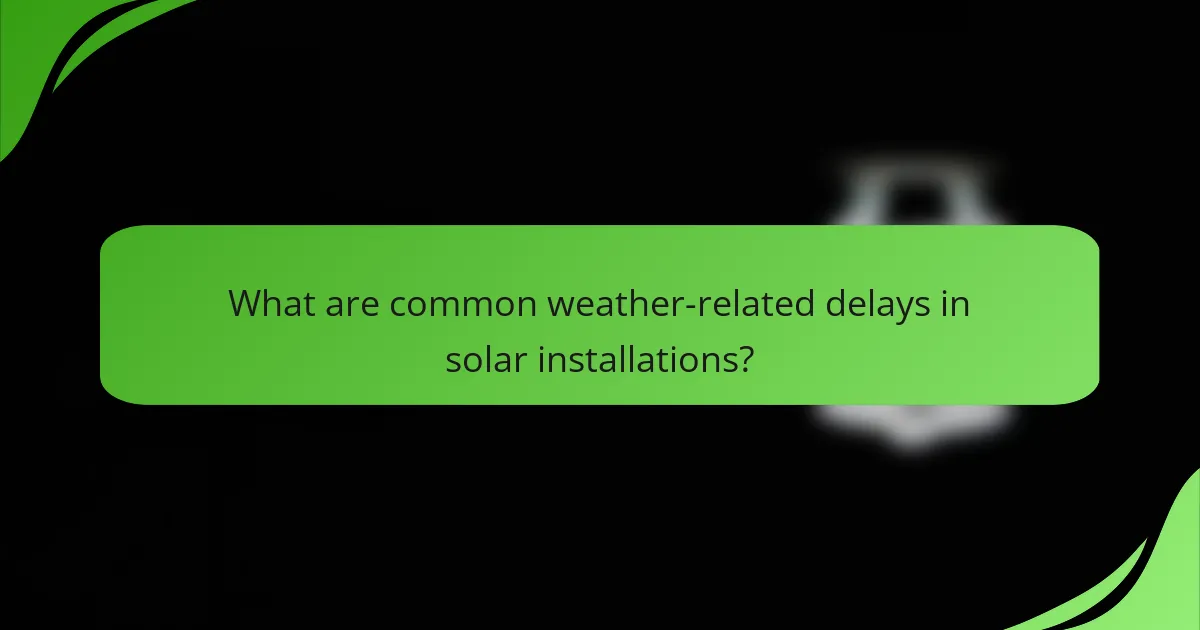
What are common weather-related delays in solar installations?
Weather conditions can significantly affect solar power installation timelines, with snow accumulation and extreme heat being two common factors that lead to delays. Understanding these impacts can help project managers plan more effectively and mitigate potential setbacks.
Snow accumulation
Snow accumulation can halt solar panel installations, particularly in regions that experience heavy winter weather. When snow covers rooftops or ground areas, it can create safety hazards and prevent workers from accessing installation sites.
To manage snow-related delays, it’s crucial to monitor weather forecasts and schedule installations during milder months. If snow is forecasted, consider preemptively clearing installation areas or rescheduling to avoid unsafe conditions.
Extreme heat
Extreme heat can also cause delays in solar installations, as high temperatures can pose health risks to workers and affect equipment performance. When temperatures soar, installation crews may need to take more frequent breaks, slowing down the overall progress.
To mitigate the impact of extreme heat, plan installations during cooler parts of the day, such as early mornings or late afternoons. Additionally, ensure workers have access to hydration and shade to maintain safety and efficiency on-site.
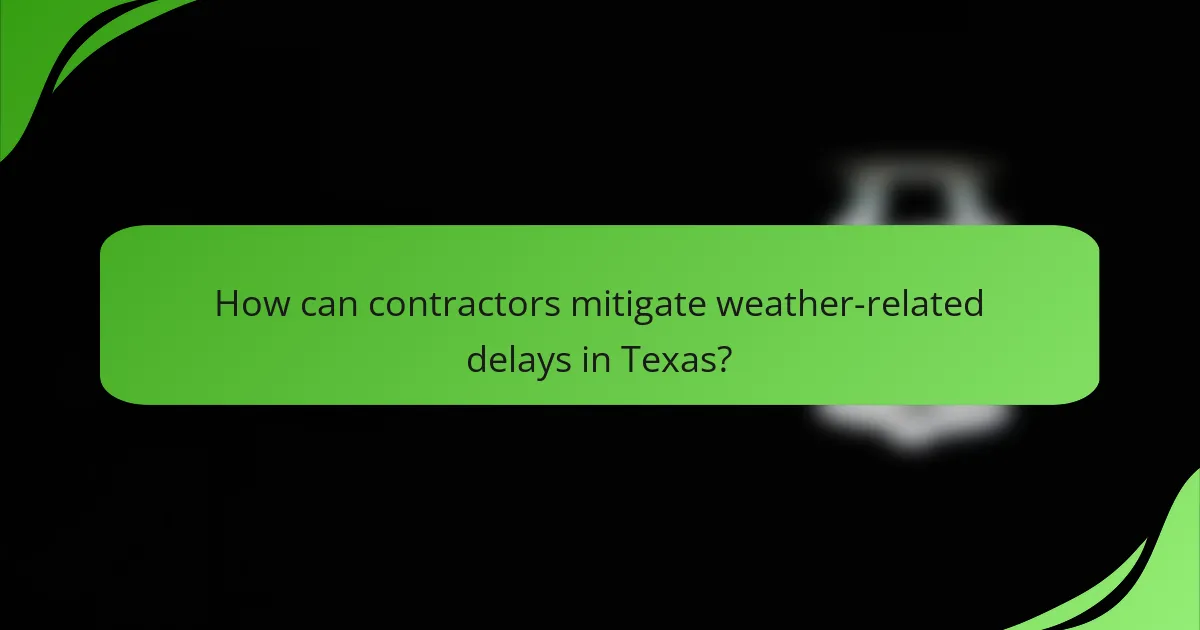
How can contractors mitigate weather-related delays in Texas?
Contractors in Texas can mitigate weather-related delays by implementing proactive planning and utilizing accurate weather forecasts. By anticipating seasonal weather patterns and adjusting schedules accordingly, they can minimize disruptions and ensure timely project completion.
Planning for seasonal changes
Understanding Texas’ diverse climate is crucial for effective planning. Contractors should be aware of peak seasons for rain, storms, and extreme heat, which can impact installation timelines. For instance, late spring and summer often bring thunderstorms, while winter can introduce freezing temperatures.
To counter these challenges, contractors can schedule installations during drier months, typically late fall or early spring. This approach helps avoid unexpected weather interruptions and allows for smoother project execution.
Using weather forecasts
Accurate weather forecasting is essential for minimizing delays. Contractors should regularly check reliable weather services for updates on impending storms or extreme temperatures. This information allows them to adjust their work schedules and resource allocation effectively.
Incorporating technology, such as weather apps or monitoring systems, can enhance decision-making. For example, if a severe storm is predicted, contractors can postpone work to prevent damage to materials and ensure worker safety, ultimately saving time and costs in the long run.

What are the prerequisites for timely solar power installations?
Timely solar power installations require careful planning and adherence to specific prerequisites, including site assessments and permitting processes. These steps ensure that installations proceed smoothly and comply with local regulations.
Site assessments
Site assessments are critical for determining the suitability of a location for solar power installation. Factors such as roof orientation, shading from nearby structures, and structural integrity must be evaluated. A thorough assessment can help identify potential issues that may delay the installation process.
During a site assessment, professionals often use tools like solar pathfinders or shading analysis software to measure sunlight exposure throughout the year. This information helps in optimizing panel placement for maximum efficiency. It’s advisable to conduct these assessments during clear weather to avoid misjudgments caused by temporary conditions.
Permitting processes
The permitting process is essential for ensuring compliance with local building codes and regulations. Each locality may have different requirements, which can affect the timeline for installation. Homeowners should check with local authorities to understand the necessary permits and any associated fees.
Typically, the permitting process can take anywhere from a few weeks to several months, depending on the complexity of the project and local regulations. Engaging with a knowledgeable installer can streamline this process, as they often have experience navigating the specific requirements in your area. It’s crucial to submit all required documentation accurately to avoid delays.
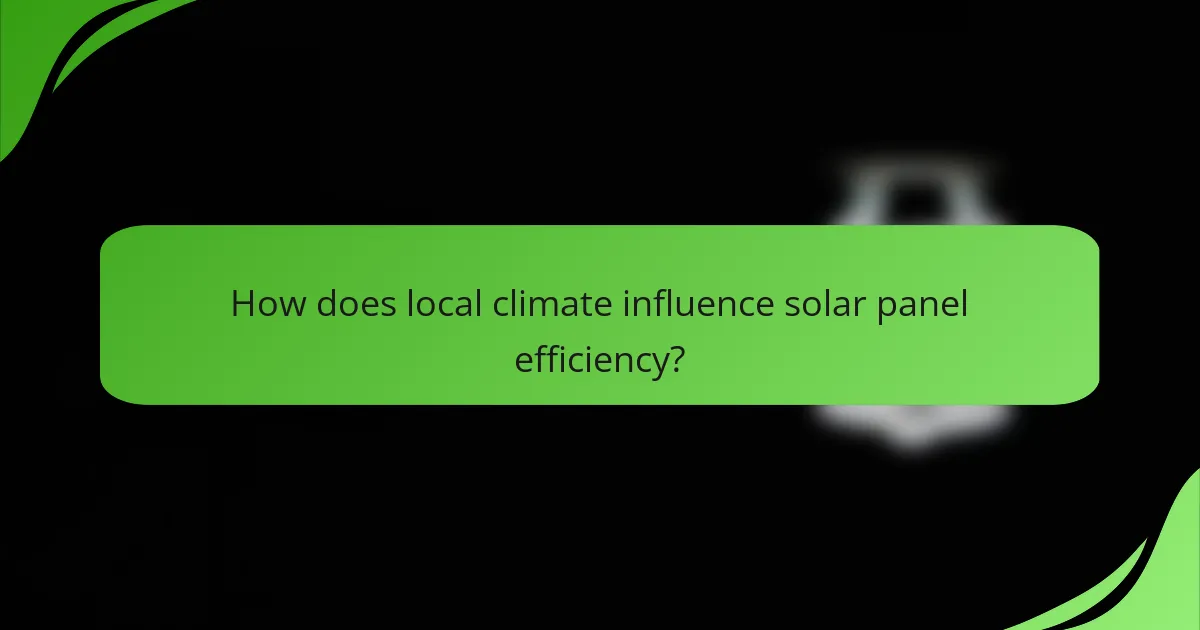
How does local climate influence solar panel efficiency?
The local climate significantly impacts solar panel efficiency by affecting how much sunlight the panels receive and how well they operate under varying conditions. Factors such as humidity, temperature, and sunlight exposure can either enhance or diminish the performance of solar energy systems.
Humidity effects
High humidity levels can lead to increased moisture on solar panels, which may reduce their efficiency. When panels are damp, they can experience a drop in performance due to light scattering and potential dirt accumulation, which can block sunlight. In regions with consistently high humidity, regular cleaning and maintenance become essential to maintain optimal energy production.
Conversely, low humidity can enhance solar panel efficiency by allowing for better light absorption and reducing the risk of moisture-related issues. However, extremely dry conditions can lead to dust accumulation, which also necessitates periodic cleaning to ensure maximum sunlight exposure.
Sunlight exposure
Sunlight exposure is a critical factor in solar panel efficiency, as more direct sunlight translates to higher energy production. Areas with longer daylight hours and fewer cloudy days typically yield better performance from solar installations. For instance, regions near the equator often receive more consistent sunlight throughout the year compared to those in higher latitudes.
When planning a solar installation, consider the local weather patterns and seasonal variations in sunlight. Using solar panels with a higher efficiency rating can help mitigate the effects of less-than-ideal sunlight conditions. Additionally, positioning panels to maximize exposure to the sun, such as tilting them at an optimal angle, can significantly enhance energy capture.

What are the emerging trends in solar installation technology?
Emerging trends in solar installation technology focus on enhancing efficiency and resilience against weather conditions. Innovations in materials and scheduling practices are making installations faster and more reliable, ensuring optimal performance regardless of environmental challenges.
Weather-resistant materials
Weather-resistant materials are crucial for solar installations, especially in regions prone to extreme weather. These materials, such as tempered glass and corrosion-resistant frames, help ensure the longevity and durability of solar panels. For instance, panels rated for high wind resistance can withstand gusts exceeding 150 km/h.
When selecting materials, consider local climate conditions. In areas with heavy snowfall, panels should have a high snow load rating, while regions with intense sunlight may benefit from UV-resistant coatings. This tailored approach can significantly reduce maintenance costs over time.
Smart installation scheduling
Smart installation scheduling leverages weather forecasts and data analytics to optimize the timing of solar panel installations. By avoiding rainy or excessively windy days, installers can enhance safety and efficiency, reducing the risk of damage to both the panels and the installation team.
Utilizing tools that predict weather patterns can help installers plan for ideal conditions. For example, scheduling installations during a dry season can minimize delays and ensure that the panels are securely mounted before adverse weather sets in. This proactive approach can lead to smoother project timelines and improved customer satisfaction.
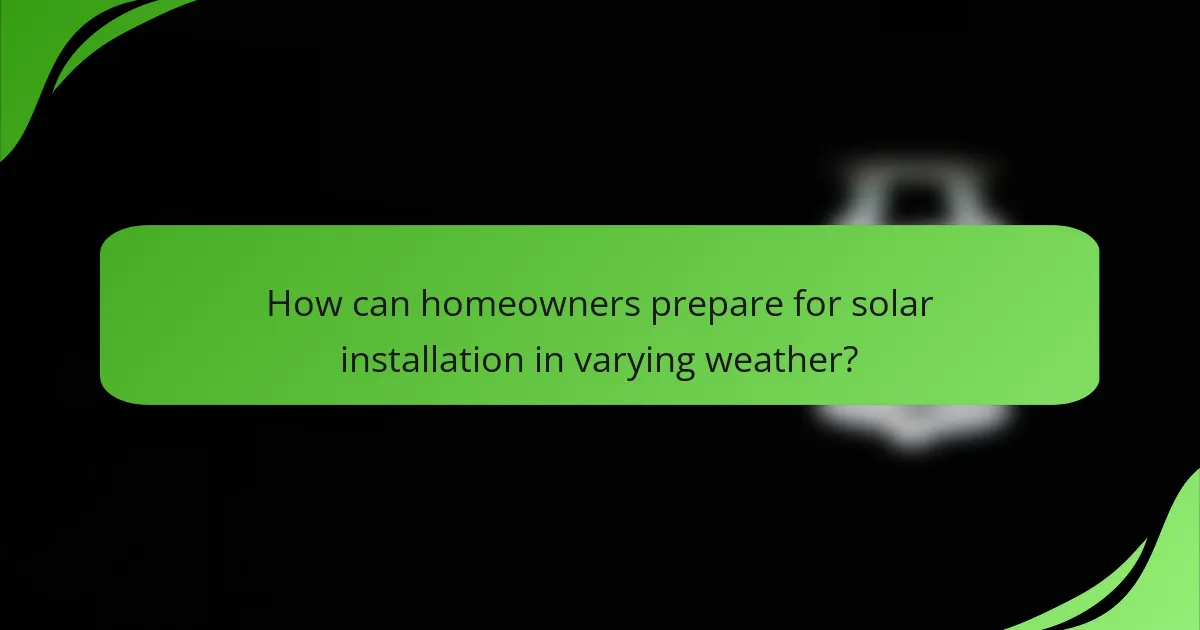
How can homeowners prepare for solar installation in varying weather?
Homeowners can prepare for solar installation by considering local weather patterns and forecasts. Understanding how different weather conditions affect installation timelines helps in planning and ensures a smoother process.
Understanding local forecasts
Local weather forecasts provide critical information for scheduling solar panel installations. Homeowners should monitor forecasts for rain, snow, or extreme temperatures, as these conditions can delay installation work.
It’s advisable to check forecasts at least a week in advance of the planned installation date. Look for consistent predictions over several days to get a reliable picture of upcoming weather.
Consider using weather apps or websites that offer hourly updates and long-range forecasts. This can help you identify the best days for installation, minimizing the risk of weather-related delays.
